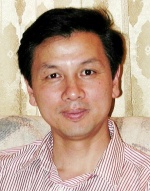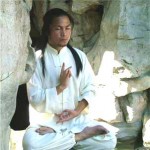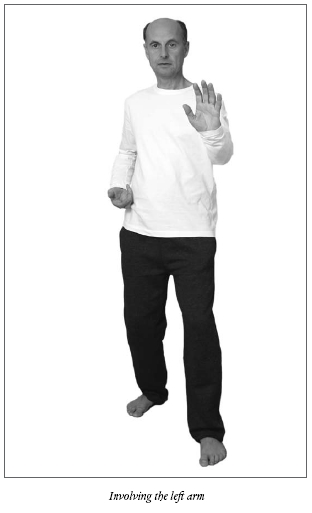 Kevin W. Chen, PhD, is an Associate Professor at the Center for Integrative Medicine and the Department of Psychiatry, University of Maryland School of Medicine, in the USA. Educated at top universities in both China and the USA, and with a PhD in research psychology and statistics, Dr. Chen has many years’ experience and training in blending Eastern and Western perspectives.
Kevin W. Chen, PhD, is an Associate Professor at the Center for Integrative Medicine and the Department of Psychiatry, University of Maryland School of Medicine, in the USA. Educated at top universities in both China and the USA, and with a PhD in research psychology and statistics, Dr. Chen has many years’ experience and training in blending Eastern and Western perspectives.
Dr. Chen is one of the few scientists to have a hands-on knowledge of Qigong practice and be actively involved in scientific Qigong research. Dr. Chen is currently funded by the National Institutes of Health (NIH) and other foundations to conduct clinical studies into the feasibility and efficacy of applying Qigong and meditative therapy in the treatment of arthritis, addiction, and anxiety disorders.
Here, Dr. Chen answers some questions about the new English translation of the textbook Chinese Medical Qigong, for which he is the Associate Editor in Chief. Professor Tianjun Liu, OMD, is Editor in Chief of both the English translation and the original Chinese editions.
Dr. Chen, how did this project come together?
The first time I met with Professor Liu was in 2002 at an international conference in Tokyo. We both presented some research and reviews of external Qigong, and found a lot of common interests in research and in our personal Qigong cultivation. We are among the few in academia who consider Qigong research as a career, and soon we became good friends.
Later Professor Liu invited me to assist him in translating his book – the only official textbook of medical Qigong in China – into English. In the beginning, I was really hesitant to take the challenge, (though I felt the endeavor was important for the field of Qigong study) since I haven’t really studied medical Qigong in a systematic way, and was afraid that I might mislead readers if I could not reflect the true meaning and values of the original book. After some lengthy discussions on other alternatives for this project, Professor Liu convinced me that the few people who might have both the language capabilities and the necessary experience in medical Qigong would never have the time to do such a big project in the near future – a project for which we did not yet have any financial support, a publisher or an assistant for editing.
After reading the book carefully, I realized how important the subject is for the field of mind-body medicine, and for the entire academic study of complementary and alternative medicine, and I felt an obligation to help the project become a reality. I also realized that I might need help with my ancient Chinese to understand the ancient literature of Qigong, and my English might not be good enough to reach the level of academic publication. We figured that those who had good knowledge in ancient Chinese might not have good English, while those who had both language skills might not have the necessary experience and knowledge of Chinese medicine and Qigong. Medical Qigong is really a special field that requires expertise across four fields – ancient Chinese, modern academic English, Chinese medicine and Qigong cultivation. Therefore, we decided that the most practical way to get the original Chinese text translated and published in English was to form a collaborative team with experts in all four areas.
It took more than five years to accomplish such a large project. First a group of Traditional Chinese Medicine (TCM) professionals in China translated the modern and ancient Chinese into English, focusing on respecting the original Chinese meanings. Then a group of bilingual American Chinese with TCM training double-checked and edited the accuracy of the English translations against the Chinese texts and smoothed out the English as best they could. Finally, a group of native English-speaking Qigong scholars and professionals edited and finalized the text for English language readers.
It is a great honor and privilege for me to have worked with so many professionals and to have participated in organizing such a rewarding project.
What differentiates medical Qigong from health Qigong?
Although there might be more similarities than differences among health Qigong and medical Qigong, the main differences may be found in three aspects:
- The difference in purpose of practice. Health Qigong is for preventive care or general well-being, and can be practiced by anyone in any condition; while medical Qigong is mostly designed for specific medical or healing purposes, and used for clinical applications of treating disease or disorders. Of course, it could be used for preventive care as well.
- The difference in delivery channels. Health Qigong can be taught by any Qigong instructor without much restriction or other requirement in health or medicine, while medical Qigong is created and practiced by medical practitioners, and delivered with specific prescription by them. This may require special clinical license or knowledge of other clinical and medical training so that the patients or practitioners can benefit from the holistic perspective of TCM.
- The difference in the practice method or limitation. Medical Qigong, especially those prescribed by medical professionals, may have certain restrictions on timing and quantity of practice, and sometimes, the practitioner is required to stop practicing once the specific symptoms disappear, just like other prescriptions in medicine, while health qigong does not have these restrictions.
Qigong hasn’t yet been fully adopted as a clinical healing modality in western healthcare systems. Why is there skepticism about the utility of Qigong to diagnose, treat and prevent illness? How does your textbook help to resolve such doubts?
It is true that there are not many qualified medical Qigong practitioners in the healthcare field, mainly due to the fact there has been no systematic training available to the healthcare professionals in our medical system, and partially due to the fact that not everyone who goes through medical Qigong training could actually become a qualified medical Qigong healer.
In general, most people who go through medical school training will get their medical license and become a doctor, but this may not be true in medical Qigong. Appropriate training with qualified instructors (who are lacking to start with) alone may not be enough to make the trainee a medical Qigong doctor. They must also commit long-term to quality Qigong practice, as well as to the Wù or Wù Xing (悟 or 悟性) for mind-body integration – the illuminative understanding or the instinct of comprehending the ineffable; in other words, an indirect way to comprehend things in energy healing. In Qigong practice, Wù may also imply the ability to integrate the comprehended knowledge, or the ineffable, into one’s Qigong practice so as to eventually be united with the Dao. Those who complete their full medical Qigong training without such a nature would never become a qualified medical Qigong healer. That is why there are so many stories from Qigong history in which the capable medical Qigong teacher seeks out the student who possesses such a Wù Xing, instead of just students searching for good teachers.
As to people’s general skepticism of Qigong, it is understandable. The concepts of Qi and Qigong healing are still new and unproven to western medicine and the general public, people tend to believe only in those things they can see or touch. There are indeed quite a few fake Qigong masters or Qigong tricksters out there disturbing the development of medical Qigong. However, as more and more research in medical Qigong becomes public knowledge, and more and more people practice Qigong or mind-body exercises themselves, I am sure there will be more acceptance of medical Qigong since the potential healing capability of medical Qigong without any side effects will really make a difference to our health and to healing.
What do you think is the significance of this book to the field of mind-body medicine in general, and specifically to Qigong practice?
Chinese Medical Qigong provides a solid foundation for bringing Qigong into the formal clinical setting as a healing tool, and establishes medical Qigong as an important academic discipline in research and teaching. It demonstrates that Qigong is not just another mind-body exercise, or mere preventive-health practice, but an important healing modality in traditional Chinese medicine that precedes herbal, acupuncture and other modalities. The book contains systematic theories, developmental history, documented knowledge and practical techniques. It has the potential to integrate different mind-body exercises, perspectives and traditions into a commonly acceptable foundation for more practical regulations, instructions, and clinical applications.
What would healthcare look like if Qigong was adopted more widely?
Because Qigong introduces the concept of self-healing and mind-body integration into health care and daily life, it has the potential to change people’s general lifestyles and philosophies of health and healing. The term “Qigong” sounds very Chinese, but the practice of mind-body-breathing exercises that have been called Qigong in China can be found in many different cultures. As you will see in the book, meditation, yoga, Reiki, Taiji quan, deep breathing and guided imagery are all described thoroughly in ancient Qigong literature, and all mind-body or energy practitioners can work under the same theory and principles to promote a similar healing philosophy: self-healing, cultivating the mind or spirit, and achieving mind-body-spirit harmony or balance through practice.
If these mind-body-spirit integration practices were adopted into our healthcare, and practiced by most people, their lifestyles and attitudes towards life would improve. As we have seen, Qigong practitioners live a less stressed, happier life in general:
“Remain detached with empty mind, the genuine Qi will follow easily; keep essence-spirit within, no illness will arise.”
– from The Yellow Emperor’s Internal Classic, regarded as the most important book in the early history of TCM.
Qigong may be the most powerful stress management tool we know today. At the same time, stress is the number one reason why people get sick and go to the doctor, accounting for 80% of primary doctor visits! Following this example, if Qigong were more widely implemented, healthcare costs would be reduced significantly and most people would feel healthier and happier.
Although we do not have hard evidence of the benefits of Qigong in double-blind, placebo-controlled trials yet, I cannot help but mention the study cited in my book introduction. A survey study in China of 500 Qigong practitioners, conducted by the Xiang-Tan City Bureau of Senior Cadres and Health Department, indicated that healthcare spending between 1992 and 1995 for those 500 government officials, mostly retirees between 50 and 70 years old, was decreased by 83% on average, in sharp contrast to the increased spending typically seen in this same age group, and 232 of them (46%) reported no medical spending at all during the same period of time. Given this stunning example, can you imagine what kind of change medical Qigong might make to our lives, and to our healthcare system?
Copyright © Singing Dragon 2010.
 Master Zhongxian Wu is the lineage holder of four different schools of Qigong and martial arts. Since 1988, he has instructed thousands of students, both Eastern and Western. He synthesizes wisdom and experience for beginning and advancing practitioners, as well as for patients seeking healing, in his unique and professionally-designed courses and workshops. Please visit www.masterwu.net for details about his teachings.
Master Zhongxian Wu is the lineage holder of four different schools of Qigong and martial arts. Since 1988, he has instructed thousands of students, both Eastern and Western. He synthesizes wisdom and experience for beginning and advancing practitioners, as well as for patients seeking healing, in his unique and professionally-designed courses and workshops. Please visit www.masterwu.net for details about his teachings.



 Master Wu has devoted himself to the study of Qigong, martial arts, Chinese medicine, Yijing science, Chinese calligraphy, and ancient chinese music for over 30 years. He was Director of the Shaanxi Province Association for Somatic Science and the Shaanxi Association for the Research of Daoist Nourishing Life Practices, and has written five books and numerous articles on the philosophical and historical foundations of China’s ancient life sciences. Visit
Master Wu has devoted himself to the study of Qigong, martial arts, Chinese medicine, Yijing science, Chinese calligraphy, and ancient chinese music for over 30 years. He was Director of the Shaanxi Province Association for Somatic Science and the Shaanxi Association for the Research of Daoist Nourishing Life Practices, and has written five books and numerous articles on the philosophical and historical foundations of China’s ancient life sciences. Visit  Your book is the result of a research study funded by the NHS. What motivated you to launch this study of Qigong and MS, and to write the book?
Your book is the result of a research study funded by the NHS. What motivated you to launch this study of Qigong and MS, and to write the book?

 Michael W. Acton
Michael W. Acton